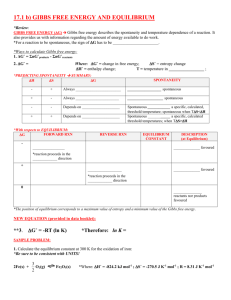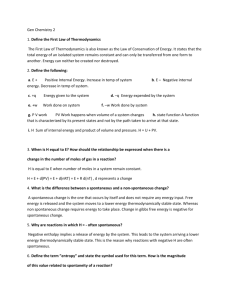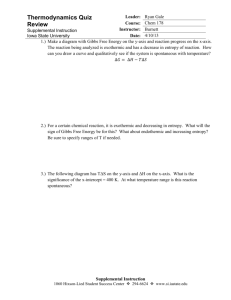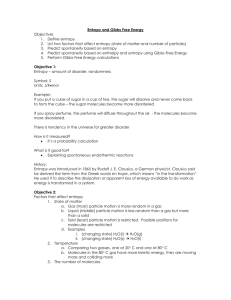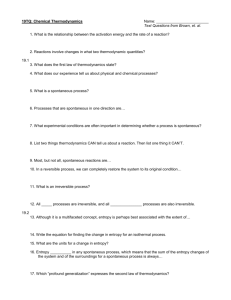Chemical Thermodynamics
advertisement
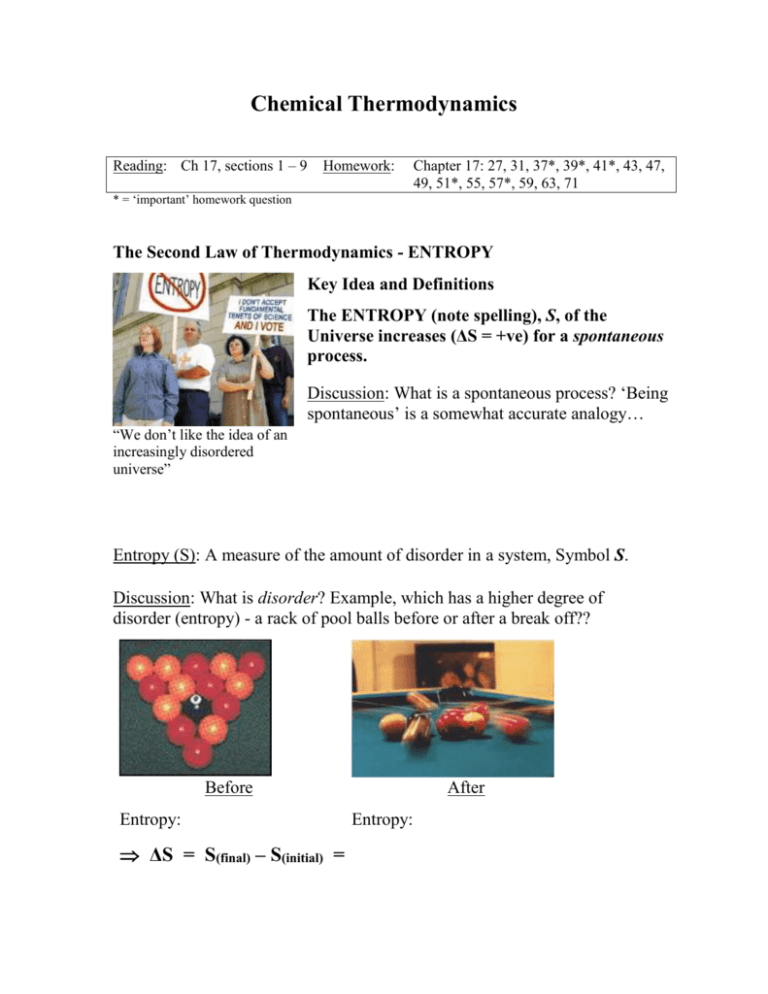
Chemical Thermodynamics Reading: Ch 17, sections 1 – 9 Homework: Chapter 17: 27, 31, 37*, 39*, 41*, 43, 47, 49, 51*, 55, 57*, 59, 63, 71 * = ‘important’ homework question The Second Law of Thermodynamics - ENTROPY Key Idea and Definitions The ENTROPY (note spelling), S, of the Universe increases (ΔS = +ve) for a spontaneous process. Discussion: What is a spontaneous process? ‘Being spontaneous’ is a somewhat accurate analogy… “We don’t like the idea of an increasingly disordered universe” Entropy (S): A measure of the amount of disorder in a system, Symbol S. Discussion: What is disorder? Example, which has a higher degree of disorder (entropy) - a rack of pool balls before or after a break off?? Before Entropy: ΔS = S(final) – S(initial) = After Entropy: Examples: Based on Entropy arguments alone, would you expect the following processes to be spontaneous (i.e. experience an increase in entropy upon completion)? Briefly explain. 1. H2CO3 (aq) H2O (l) + CO2 (g) Observation 2. The air drying of washing up or clothes on a washing line H2O (l) H2O (g) “The 2nd law will take care of it”… Observation 3. NaCl (s) NaCl (aq) Observation (see more detailed figure below) 4. The diffusion of any gas Observation Task: List at least three entropy driven processes (see appendix for examples) Just like with Enthalpy (H), each material has an inherent amount of entropy. All S values are measured in J/mol K and are always positive. The magnitude of S indicates the relative amount of disorder for the material. Standard Entropy values can be used (in a similar way to ΔHf values) to find ΔS for any reaction. See Appendix. Example: Calculate ΔS for the following reaction: CCl4 (l) CCl4 (g) ; ΔS = _____________ Given: CCl4 (g), S = 309.4 J/molK CCl4 (l), S = 214.4 J/molK What conclusion can you make regarding the evaporation of CCl 4 (l)? Math considerations – the second law of thermodynamics Entropy is temperature dependant – the hotter a material is the more entropy it has (standard entropies form Appendix C are calculated at 25oC, 1.00 atm). This fact is conveyed in the formal mathematical description of the 2 nd law: S= qrev T For chemical systems that do not do ‘PV’ work, ΔH = q (first law), therefore: S= ΔH T Wrap up Discussion: If all spontaneous processes result in an increase in entropy, how can processes that result in a decrease in entropy (such as the freezing of water) for a material ever occur?? Gibbs Free Energy Gibbs free energy (ΔG) for a reaction relates ΔH and ΔS for that reaction. Simply, the mathematical sign of ΔG, determined via the Gibbs equation, determines if a reaction will ever work (is spontaneous); will never work (in non-spontaneous) or at equilibrium. Spontaneous: ΔG < 0 Non-spontaneous: ΔG > 0 Equilibrium: ΔG = 0 Gibbs Free Energy Equation: ΔG = ΔH - T ΔS The sign of ΔG (and, therefore, if a reaction is spontaneous) depends on the signs of ΔH and ΔS. See appendix. Task: Complete the following table / determine the sign of ΔG ΔH ΔS -ve -ve -ve +ve +ve -ve +ve +ve ΔG spontaneous As with ΔH and ΔS, ΔG is a state function. ΔG values follow the same ‘state function’ math rules as the ΔH and ΔS, so can be determined from these quantities. Slides ‘Huge’ worked Example: The thermite reaction is used to weld railway tracks: Fe2O3 (s) + 2 Al (s) 2 Fe (s) + Al2O3 (s) Based on the below data, determine if this reaction is spontaneous at 25oC and quote the value of ΔG in kJ/mol Given: ΔHf Fe2O3 (s) = - 822.16 kJ/mol ΔHf Al2O3 (s) = - 1669.9 kJ/mol Plan: Find ΔH, ΔS, and then find ΔG S Fe2O3 (s) = +89.96 J/molK S Al2O3 (s) =+51.00 J/molK S Fe (s) = +27.15 J/molK S Al (s) = +25.32 J/molK Free Energy and Equilibrium Recall: For and equilibrium, ΔG = 0. In terms of the equilibrium constant K and other variables ΔG = -RT lnK Where: K = equilibrium constant (no units) ΔG = Gibbs Free energy (kJ/mol) R = 8.314 J/molK T = temperature in Kelvin Task: Rearrange the above equation to find an expression for K in terms of ΔG Group activity: Use the standard ΔG values in appendicies to find K at 25oC for: N2 (g) + 3 H2 (g) 2 NH3 (g) Plan: Find ΔG, find K “Gibbs” Question 1 (25 points): Using the thermodynamic information given in the data sheet, calculate Go for the following reaction: Fe2O3 (s) + 6 HCl (g) 2 FeCl3 (s) + 3 H2O (g) Appendix

